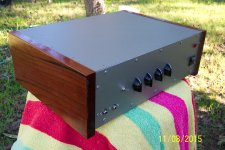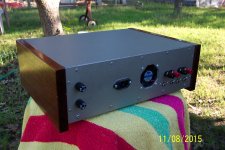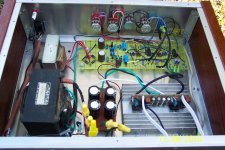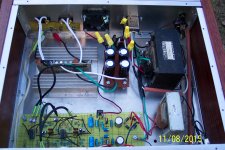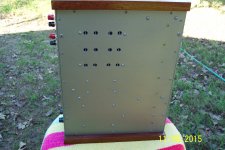sure, not the brightest idea to get verry close to the absolute ratings, specially with an unregulated supply.
but it ain't that close at all.
In what way it is not close? It's off the charts on most parameters on the data sheet.
sure, datasheet test parameters are done with smaller rails.
it still probably saggs and has losses to make that 38-39 volt go down to about 35 or even less.
do not treat the rails as if they where well regulated and kept at constant value.
and then you will see it ain't that close to limits at all.
check the TI datashett, +-40 volt is still on chart.
the supply in question does not reach +-40 volts even unloaded.
it still probably saggs and has losses to make that 38-39 volt go down to about 35 or even less.
do not treat the rails as if they where well regulated and kept at constant value.
and then you will see it ain't that close to limits at all.
check the TI datashett, +-40 volt is still on chart.
the supply in question does not reach +-40 volts even unloaded.
Pictures
The meter reads +-42 Volts> Believe it
The formula 56x1.414=79.18
The meter=84v
This is what it's all about:
The meter reads +-42 Volts> Believe it
The formula 56x1.414=79.18
The meter=84v
This is what it's all about:
Attachments
it still probably saggs and has losses to make that 38-39 volt go down to about 35 or even less.
This is what I asked the OP, and he never answered. I always measure voltage supply droop under various conditions whenever I have equipment opened up (sometimes just out of curiosity) and it varies widely but it always droops. In fact, it always droops even at idle.
I think it was you that pointed out that circuits usually "sound better" with higher voltage and I have always found this to be true. Higher voltage increases linearity and this is well known.
And finally, musical program is different than sine waves. Some cheaper equipment has smaller transformers and hence they can use smaller heatsinks. The power supply will collapse before the circuit overheats. The most extreme example I've seen of this in consumer grade equipment is a tabletop "hi-fi" that can produce 50 watts with a tone burst but only 12 watts steady state, into 6 ohms. And you know what? It sounds pretty powerful into medium efficiency 6 ohm speakers. It's my computer sound system amplifier.
It would be instructive to measure the steady state output of the OP's amplifier. I'm pretty sure that it's better than the example I gave, but the point is that this strategy works and it's not new.
Either A or B is a lie, pick one.a) The formula 56x1.414=79.18
b) The meter=84v
Unless you believe 79.18=84 , that is
Part of the 28 Volt AC doesn't mean 42 volt rails can be resolved as follows.
A transformer with a 28 Volt winding is rated for 28 Volts when delivering the rated current into a resistor. To do that, the open circuit, or lightly loaded voltage out is typically 6% to 10% higher. That amount is specified by the transformer's "regulation" spec. Smaller transformers tend toward the 10% regulation. Very large ones might show a 3% regulation number.
Thus, at light loads, a 28 Volt transformers winding voltage would be about 28*1.08=30.24 volts RMS. Multiply that by sqrt(2)=1.414, and you get peak voltage of 42.76 Volts. Take away 1 diode drop, about 0.76 volts, and you're very near the reported 42 volts for each rail.
Update My Dynaco
Akitika Preamp and Power Amp Kits
A transformer with a 28 Volt winding is rated for 28 Volts when delivering the rated current into a resistor. To do that, the open circuit, or lightly loaded voltage out is typically 6% to 10% higher. That amount is specified by the transformer's "regulation" spec. Smaller transformers tend toward the 10% regulation. Very large ones might show a 3% regulation number.
Thus, at light loads, a 28 Volt transformers winding voltage would be about 28*1.08=30.24 volts RMS. Multiply that by sqrt(2)=1.414, and you get peak voltage of 42.76 Volts. Take away 1 diode drop, about 0.76 volts, and you're very near the reported 42 volts for each rail.
Update My Dynaco
Akitika Preamp and Power Amp Kits
small transformer regulation is very much higher than 10% expect upto 30% for small transformers.
I have 5VA & 6VA that measure 30%. I don't have a 3VA, or smaller, to measure.
At very low load the diode drop can be much less than 760mVf.
I use 500mVf for finding the worst case smoothing capacitor voltage rating.
I have 5VA & 6VA that measure 30%. I don't have a 3VA, or smaller, to measure.
At very low load the diode drop can be much less than 760mVf.
I use 500mVf for finding the worst case smoothing capacitor voltage rating.
Did the OP just have his account disabled??
Thats a bit odd isn' it..
Perhaps he didn't like to hear that he had actually chosen wrong transformer for the amp
He's disappointed that he couldn't pull the wool over the eyes of actual engineers?
- Status
- This old topic is closed. If you want to reopen this topic, contact a moderator using the "Report Post" button.
- Home
- Amplifiers
- Chip Amps
- LM3886 Power Output
